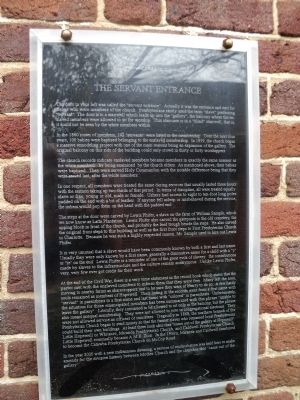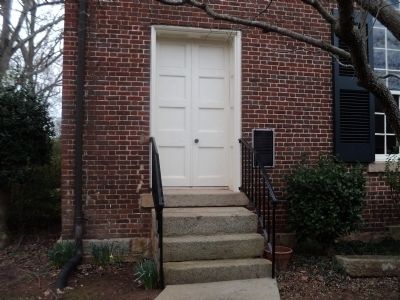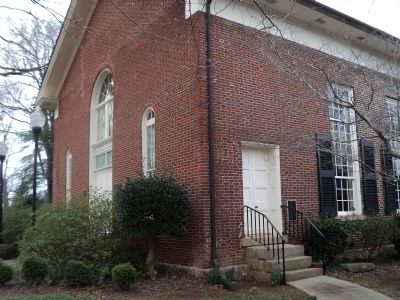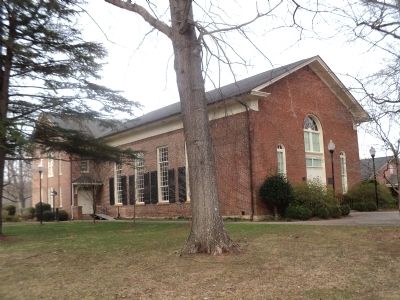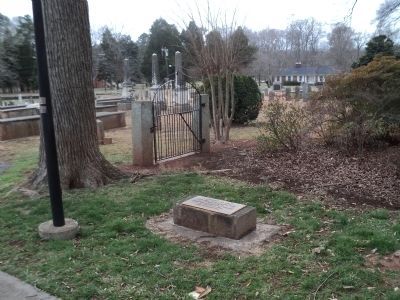Huntersville in Mecklenburg County, North Carolina — The American South (South Atlantic)
The Servant Entrance
The door to your left was called the “servant entrance”. Actually it was the entrance and exit for slaves who were members of the church. Presbyterians rarely used the term “slave” preferring “servant”. The door is to a stairwell which leads up into the “gallery”, the balcony where the enslaved members were allowed to sit for worship. This staircase is a “blind” stairwell, that is, it could not be seen by the white members within.
In the 1860 roster of members, 142 “servants” were listed in the membership. Over the next four years, 100 babies were baptized belonging to the enslaved membership. In 1859, the church began a massive remodeling project with one of the main reasons being an expansion of the gallery. The originally balcony on this side of the building could only crowd in thirty or forty worshippers.
The church records indicate enslaved members became members in exactly the same manner as the white members: by being examined by the church elders. As mentioned above, their babies were baptized. They were served Holy Communion with the notable difference being that they were served last, after the white members.
In one respect, all members were treated the same during services that usually lasted three hours with the sermon taking up two-thirds of that period. In terms of discipline, all were treated equally slave or free, young or old, male or female. Ushers had access to eight to ten-foot long poles padded on the end with a bit of leather. If anyone fell asleep or misbehaved during the service, the ushers would pop them on the head with the padded end.
The steps at the door were carved by Lewis Phifer, a slave on the farm of William Sample, which we now know as Latta Plantation. Lewis Phifer also carved the gateposts to the old cemetery, the upping block in front of the church, and probably the feed trough beside the steps. He also carved the original front steps to this building as well as the first front steps to First Presbyterian Church in Charlotte. Because he was such a highly respected mason, Mr. Sample used to hire out Lewis Phifer.
It is very unusual that a slave would have been commonly known by both a first and last name. Usually they were only known by a first name, generally a diminutive name for a child with a “y” or “ie” on the end. Lewis Phifer is a reminder of one of the great evils of slavery: the contributions made by slaves to the infrastructure and the culture remain anonymous. Unlike Lewis Phifer, very, very few ever got credit for their work.
At the end of the Civil War, there is a very terse statement in the record book which states that the pastor met with the enslaved members to inform them that they were free. Many left the area, moving to nearby farms as sharecroppers just to be sure they were at liberty to do so. A few hardy souls remained as members of Hopewell. Their listing in the records went from a first name with “servant” in parenthesis to a first name and last name with “colored” in parenthesis. Unfortunately, the situation for those emancipated members has been summarized with the phrase “unable to leave the gallery”. Literally, they continued to be allowed to sit only in the balcony, but the phrase also meant unequal membership. They were not allowed to vote in congregational elections. They were not allowed service as officers or ministers. Tragically in 1868, the northern branch of the Presbyterian Church began to send money so that the former slaves who remained loyal Presbyterians could build their own buildings. At least three such churches “came out of the gallery at Hopewell”: Little Hopewell or Whitacre, Miranda Presbyterian Church, and Caldwell Presbyterian Church. Little Hopewell eventually became A.M.E. Zion. In the 1950’s, Miranda and Caldwell combined to become the Catawba Presbyterian Church on McCoy Road.
In the year 2000 with a new millennium dawning, a service of reconciliation was held here to make amends for the divisive history between Mother Church and the churches that “came out of the gallery”.
Topics and series. This historical marker is listed in these topic lists: African Americans • Churches & Religion. In addition, it is included in the African Methodist Episcopal Zion (AME Zion) Church series list. A significant historical year for this entry is 1860.
Location. 35° 21.977′ N, 80° 53.892′ W. Marker is in Huntersville, North Carolina, in Mecklenburg County. Marker can be reached from Beatties Ford Road north of Sample Road, on the right when traveling north. Marker is located on the east side of the Hopewell Presbyterian Church. Touch for map. Marker is at or near this postal address: 10500 Beaties Ford Road, Huntersville NC 28078, United States of America. Touch for directions.
Other nearby markers. At least 8 other markers are within walking distance of this marker. Hopewell Presbyterian Church (a few steps from this marker); “Upping Block” (within shouting distance of this marker); William Bain Alexander (within shouting distance of this marker); John McKnitt Alexander (within shouting distance of this marker); William Graham (within shouting distance of this marker); In Memory of the Revolutionary War Patriots of Hopewell Presbyterian Church (within shouting distance of this marker); General William Lee Davidson (within shouting
distance of this marker); The Oldest Cemetery and the Walls (within shouting distance of this marker). Touch for a list and map of all markers in Huntersville.
Credits. This page was last revised on June 16, 2016. It was originally submitted on February 12, 2013, by Bill Coughlin of Woodland Park, New Jersey. This page has been viewed 938 times since then and 74 times this year. Photos: 1, 2, 3, 4, 5. submitted on February 12, 2013, by Bill Coughlin of Woodland Park, New Jersey.
